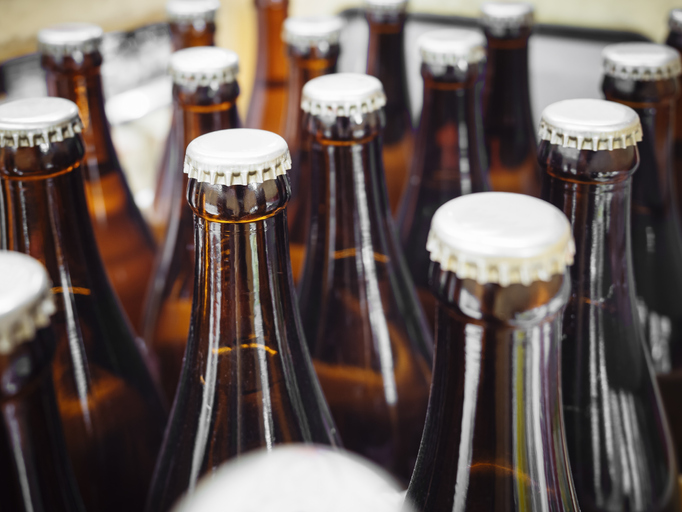Share this post
Transporting wine, beer and spirit with intermodal terminals
As an importer, you want the transportation of your wine, beer, or spirits to be as smooth as possible. To help you achieve this, it pays to understand all the ins and outs of any typical shipment’s journey. Intermodal terminals are one of the key linchpins of modern freight transportation.
Read on to discover the role of intermodal terminals and what advantages they can bring to your supply chain.
What is an intermodal terminal?
Intermodal terminals, also often referred to as freight terminals, are designed to act as domestic or international transfer points bridging the gaps between transport networks.
Taking advantage of the flexibility and convenience of intermodal containers, intermodal transport involves the use of at least two different modes of transport for beverage shipments.
This means your alcoholic beverages can be switched from one type of transportation to another without unloading and reloading containers.
What are intermodal routes?
Intermodal routes are for transporting beverages on journeys that incorporate more than one mode of freight transport.
These routes need to be carefully planned and coordinated to optimize the transfer of goods from origin to destination.
The planning must take into consideration several factors including distance, cost, transit time, and environmental impact. The goal is to leverage the strengths of each mode of transport - for instance, the speed of air transport, the capacity of sea freight, and the flexibility of road transport - to achieve the most efficient and cost-effective transport solution.
On a typical intermodal route, your wine, beer, or spirits will be transported by truck to an intermodal terminal from the winery, brewery, or distillery. At the terminal, the container can be offloaded from the truck and loaded onto rail cars or a ship for their onward journey. This process is known as intermodal shipping.
The ability to switch between modes allows you to take advantage of the strengths of each type of transport. For example, trucks are flexible and often the best or only choice for short distances, while trains and ships are better options for moving your beverages longer distances and can handle larger numbers of shipments.
What’s more, by serving as a hub for shipments, intermodal terminals reduce the risk of damage and loss and minimize the frequency of handling, helping preserve the quality and integrity of your beverages.
The use of intermodal terminals also benefits the environment. By allowing you to switch from road freight to ship or rail for long-distance cargo journeys, you can reduce your greenhouse gas emissions.
This is why intermodal terminals are critical components of the supply chain, they allow for the optimization of each transport leg, reducing costs, enhancing overall logistics efficiency, and enabling the swift and secure movement of wine across nations and borders to connect you to key markets.
What are the types of intermodal terminals?
There are three major types of intermodal terminals: Rail terminals, port terminals, and truck terminals.
Intermodal rail terminals
As the name suggests, these specialize in the transfer of goods between rail and other modes of transportation. Intermodal rail terminals are usually located near major railway lines and act as critical junctions for freight to be offloaded from trucks or ships and loaded onto trains or vice versa.
These facilities are equipped with essential infrastructure including tracks, platforms, and cranes to handle large volumes of containers.
A key advantage provided by rail-based intermodal terminals is the ability to move large quantities over considerable distances quickly and efficiently.
Access to rail freight also allows you to minimize the risk posed by road congestion and enhances the resilience of your supply chain by providing an alternative form of transport in the event of disruptions to other modes.
Another benefit is that rail transport is more environmentally friendly compared to road transport because it produces fewer carbon emissions.
Intermodal port terminals
Built within or close to shipping ports, these terminals are designed to facilitate the transfer of goods between sea and land-based transportation modes to and from ships, trains, or trucks.
Their complex infrastructure includes large container yards for storage, straddle carriers and gantry cranes for lifting and moving containers, along with road and often rail access for the transportation of goods inland.
Given that sea freight is the primary mode for international trade, intermodal port terminals serve as a gateway for the import and export of goods and have the capacity to handle massive volumes of your beverages, connecting you to global markets.
Intermodal truck terminals
These terminals are purpose-built for the transloading or cross-docking between trucks and other modes like rail or shipping.
Constructed close to highways and major roads, intermodal truck terminals are equipped with loading docks, storage yards, and cranes, allowing for the efficient moving of beverages between trucks, trains, and ships.
An essential part of the last-mile delivery process, these terminals excel in their flexibility as trucks can reach areas that are inaccessible by rail or sea.
Spotlight on Chicago’s CenterPoint Intermodal Center
Due to its strategic location in the midwest and an extensive intermodal freight system, the Chicago area is one of the most important freight hubs for importing into the United States.
It’s an interchange point between western and eastern rail networks and roughly 50% of the country’s intermodal trains and 25% of all freight trains pass through the city.
It’s a key location for road freight too. One in seven vehicles on the Illinois urban interstate network is a truck and some Chicago facilities serve more than 30,000 trucks per day.
Air and water are also easily accessed from the region. O’Hare airport is one of the largest air-freight hubs in the US and Chicago enjoys access to both the Great Lakes and Mississippi River maritime systems with links to the Atlantic Ocean and the Gulf of Mexico via inland canals and rivers.
So, whether you’re importing into or exporting from the US, it’s likely your beverages will transit the Chicago area at some point.
One of the most important intermodal terminals is the CenterPoint Intermodal Center (CIC) located in Elwood, Illinois.
Considered to be the largest inland port in North America, the 6,400-acre facility handles over 3 million TEUs (twenty-foot equivalent unit) per year.
Located 40 miles southwest of Chicago, the center opened in 2002 and was constructed to be the focal point of the area’s transportation infrastructure.
CIC sits near the major I-55/I-80 highway and is home to the BNSF Logistics Park
Chicago, North America’s most active inland rail terminal, and the Union Pacific Joliet Intermodal Terminal.
The center offers international intermodal service to and from every major West coast port and East coast ports are served by interline services via the Norfolk Southern Railway and CSX.
It also provides on-site storage facilities for containers, trailers, and equipment and 24/7 fire and police protection.
Embrace intermodal terminals for wine importing
By partnering with an experienced beverage logistics partner like Hillebrand Gori you can leverage the strengths of intermodal terminals. We can help you navigate the complexities of harnessing multiple modes of transport throughout the global supply chain.
Contact us today for expert advice about how to take full advantage of all the possibilities intermodal terminals offer to optimize your logistics operations, reduce your costs, and enhance your business.
Published 22nd December 2023
Multimodal transportation involves more than one mode. In intermodal transportation you can move the container between different modes without needing to unpack/reload the contents.
Rail-to-truck or truck-to-rail is the most common form of intermodal transportation. Your beverages move by truck for the first and last miles and by rail for the majority of the journey.
The most common types of intermodal containers come in two sizes, twenty foot and forty foot. They are suitable for bottled wine and, if you are bulk shipping liquids, a flexitank can be placed inside them too. Other types of container include refrigerated containers and insulated containers which are recommended for protecting sensitive products like wine from the risks of temperature and humidity.
A terminal is a space or location specifically designed for the loading or unloading of cargo into or out of a vehicle or vessel for transport.
How can we help your business grow?





